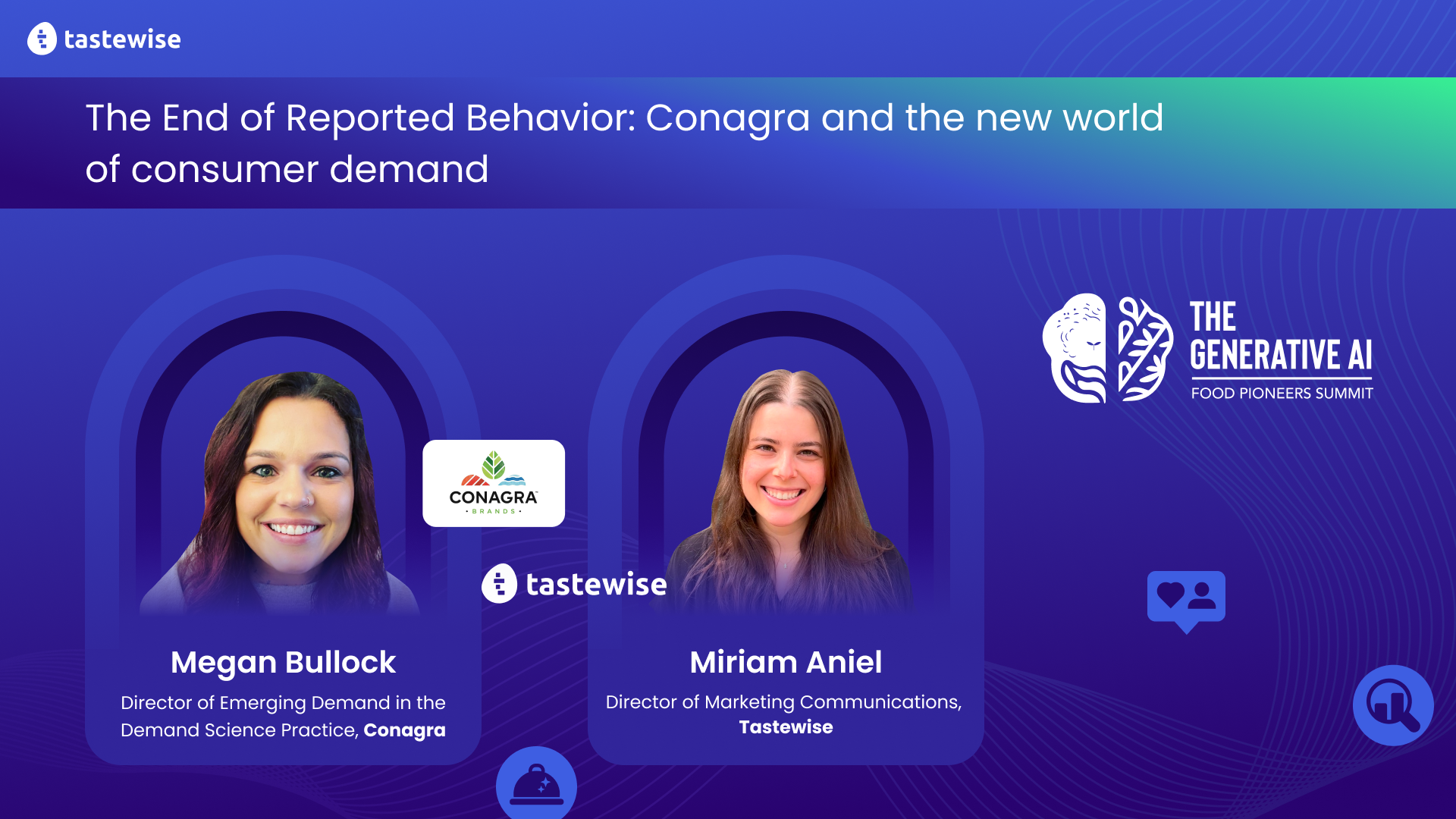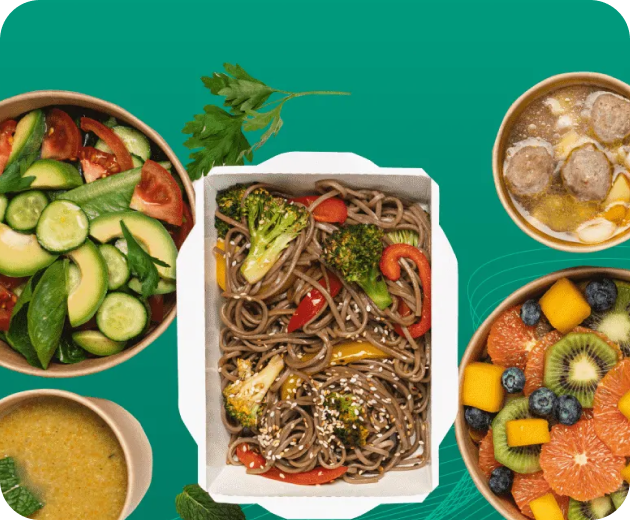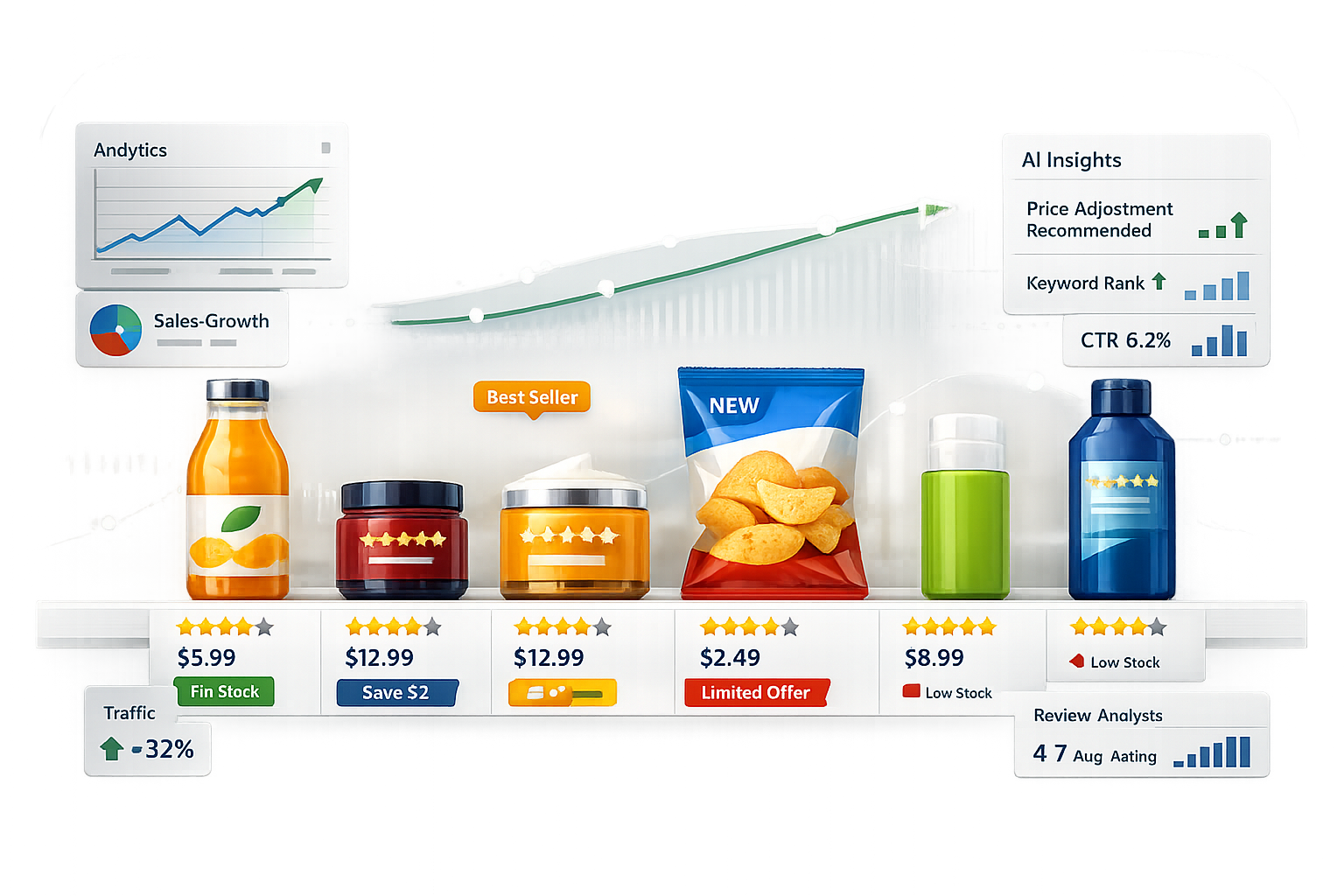The End of Reported Behavior: Conagra and the New World of Strategic Insights
- Megan Bullock Director, Predictive Science, Conagra Brands
- Miriam Aniel Oved Director, Marketing Communications, Tastewise
Join Megan Bullock, Director of Predictive Science at Conagra Brands, as she unveils how AI is reshaping the food industry. Explore cutting-edge predictive models and innovative AI applications that drive product development, enhance sustainability, and revolutionize consumer experiences. Discover how Conagra leverages AI to stay ahead in a competitive market through strategic insights.

[00:01:00]
Miriam Aniel Oved: Welcome, everyone. Thank you for joining us for our next session. My name is Miriam. I am the Director of Marketing Communications here at Tastewise. I am joined today by Megan, Director of Emerging Demands within Conagra’s Demand Sciences practice. We’ll be spending the next 20 to 25 minutes or so discussing the end of reported behavior, how Conagra uses the new world of consumer demand. And Megan will be sharing with us her perspective, which we’re really looking forward to. So, Megan, can you kick us off please by telling us a little bit more about yourself and what you actually do within the world of Emerging Demand?
Megan Bullock: Yes. Hi, everyone. Happy to be here. It’s been a while since I’ve spoke at a Tastewise conference, but happy to be back for round two. So as Miriam said, I head up our Emerging Demand practice at Conagra. Ironically, it’s the team I started at at Conagra about six years ago. I’ve made a couple of rotations throughout the department since then on our Behavioral Science team, working more closely with brands; on our Data Science team, of course, being a lot closer to our data. And now I’m back full circle leading our Emerging Demand team.
[00:02:00]
Megan Bullock: So a little bit about what that is, is we are a brand category-agnostic portfolio-wide support function. Really trying to understand consumer macro behavior. What are growing behaviors? What are declining behaviors? How are consumers thinking about health in the context of food and drink? What are new diets they’re following? What are ingredients that are resonating to them? Where are they consuming food? How are they consuming food? What recipes are they interested in? But also kind of cultural moments, too. What are cultural icons that we could tap into? What are other areas that they’re spending their money that are competing with food and beverage spend? So it’s really a broad spectrum of things that my team tackles to help again the whole portfolio make smart decisions, largely as it relates to innovation, but a plethora of other decision-making functions that we support.
Miriam Aniel Oved: Fabulous. Thank you for sharing. I love the holistic approach
[00:03:00]
Miriam Aniel Oved: the you all are taking towards understanding the consumer, everything from the behavioral science side of things, the trends themselves, the cultural moments. I think there’s a lot there to unpack, and hopefully we’ll get to talk about all of that and more. As we kind of jump into the conversation, I’m curious to understand how you and your team and Conagra broadly really get close to the consumers. When you’re thinking about consumer trends and what consumers care about, tell me a little bit about the lenses that you approach that project through.
Megan Bullock: Yes, of course. So there’s many lenses that we look at. My team specifically, there’s a couple of core lenses. Health, for sure, how that comes to life, and not just in food and drink, we’re often looking at adjacent categories. At supplements, for instance, as a more emerging source. The supplements trends typically go to then drinks and then to food, so snacking, etcetera. Also just like what are macro trends happening in terms of gym attendance or what people are trying to do outside of food and beverage to maintain healthy lifestyles. So
[00:04:00]
Megan Bullock: modern health has always been a huge pillar that we look at. But also on the other spectrum, there’s how are consumers wanting to indulge in food? What are new flavor profiles? What are new experiences, new forms? That’s where a lot of social data comes into play here because there’s so much creativity happening online. Consumers are riffing off of chefs. They’re riffing off of food service, and vice versa. So there’s a ton of inspiration to pull from there. And it’s really important to understand what are the biggest behaviors that we can capitalize on versus what are kind of flashing one-hit wonder moments. So those are two really big pillars, but we’re also looking at specific audiences, specific channels, and how consumer behavior differs. By channel I mean, what’s the natural channel grocery shopper looking to purchase in their store shop versus maybe a club shopper, right? I guess those are kind of four topical pillars as we’re thinking about our current innovation
[00:05:00]
Megan Bullock: pipeline. But believe me, the sky’s the limit when it comes to our wheelhouse and what we can tackle to better understand that consumer.
Miriam Aniel Oved: Yeah, that makes a lot of sense. And I think as you’re surfacing all of the various things that you think about — so how are consumers being influenced? What are the diverse identities that they bring into the decisions that they’re making? What are the various demands on their plate, if you will? No pun intended. And as we’re thinking, too, what they’re eating and drinking. I think that begs the question, how do we actually access all of that information around consumers? And that brings me to my next question, which is what we’re going to get into today, Conagra, as I understand it, stopped using primary research in 2015. And I know that a lot of folks on the call are thinking through, what does that mean, stop using primary research? If we want to understand our consumers, what are ultimate ways of doing that? So I know that you all are embracing really this observed behavioral data, which makes a lot of sense in the context of behavioral science as well, to really uncover and predict those consumer demands and
[00:06:00]
Miriam Aniel Oved: consumer trends. So can you tell me a little bit what that switch has meant for innovation in your team and more broadly and just a little bit more around what motivated that switch and how that actually gets you closer to your consumers?
Megan Bullock: Yeah, for sure. So you have it exactly right. The word “surveys” is an off-limit word at Conagra, because we have transitioned for many years now to more observable behavioral data. And why that is is multifaceted. But by and large, what consumers say is going to look a lot different than what consumers do. When they’re talking to you via a survey, it’s going to be a lot more aspirational versus the reality, which is going to be easier, better understood, rather, in that behavioral data. You know, at this point in time, with living in such a digital world, there are so many breadcrumbs, if you will, of consumer behavior that can signal what is attractive demand. You know, consumers are searching things on Google Search, what they want to
[00:07:00]
Megan Bullock: eat for dinner that night. What are the shortcuts they’re looking for? What are the pain points they have? They’re creating recipes on social media. They’re communicating with their social networks on social media that can kind of tee up opportunities. They’re shopping in the grocery store, and we can understand what are the attributes of the products that they’re buying, what are the bundle of set of attributes these products have; what are the things that are in the basket at the same time, which can really tee up a job of what that consumer is looking for. When they’re going to food service, even, like what the menu items that they’re looking to buy, and what are food service new items that are launching? And we can kind of be in the know of that. So there are so many data points for us at our fingertips that we can triangulate today to really understand who the consumer is and the reality. I mean, even to the point of how are they consuming the food when it comes home, like what does that consumption moment look like, who’s at the table, what other foods are consumed? So I think we’re making far more
[00:08:00]
Megan Bullock: well-rounded, evidence-based decisions versus the rather faulty data that comes out of a survey that is almost teeing up the consumer to say that they’re going to buy something that maybe, sure, if the circumstances was right, they would try, but it’s not necessarily solving a job. We kind of use the jobs to be done framework to tee up a unmet need that that consumer has. So kind of a long-winded answer. But, I mean, I think it makes my job so much more interesting to have all of those data sources at my fingertips in a moment’s time, because, I mean, I’m answering hundreds of business questions within one day. Versus if we were relying on survey data, we could commission a study, which would maybe take two weeks, plus an eight to 10 week turnaround time, not to mention thousands of dollars. So I also think, I mean, this method is cost effective and efficient and fast. And we feel really good about the decisions that we’re making off of it.
[00:09:00]
Miriam Aniel Oved: Right. And I think it ultimately allows you to serve consumers even better at speed and scale.
Megan Bullock: Exactly. If you’re able to make decisions faster and you’re able to actually access what consumers care about in a different way rather than what they’re just telling you. That’s not to say that consumers themselves are not trustworthy. But I think it means that there’s so much more to consumers than maybe they’re able to articulate in a single moment, where I think the psychological term is like the well has been poisoned, right?
Miriam Aniel Oved: Right. Like we’re leading them in a certain direction. And I think new tools are definitely needed. One of my colleagues likes to say that I think really hits the point here, we feel this ourselves as consumers, right? If someone were to ask us on a survey, how often do you sit in front of your freezer eating ice cream at 2:00 in the morning, our answer to that might be a little different than zero, right? But if I was finding a different way to express that and not in a formal survey setting, we might actually get closer to the truth. So for me, the answer to that would be not zero percent.
Megan Bullock: I mean, another very top-of-mind example
[00:10:00]
Megan Bullock: is we’re currently kind of studying the GLP-1 consumer, which I’m sure the industry is all about right now. But we do have some data at our fingertips that looks at what they’re looking to get more of in their diet, looking to get less of, looking to get more protein, more vegetables, more fruit, etcetera, etcetera, less sugar. And then you look at the actual data tracking what they’re actually consuming in home and mapping it to the caloric intake, to the nutrient intake, and there is such a differential between what they say they want to eat more of and what they’re actually eating more or less of. And I think that was a stark recent reminder of the importance of looking at that more behavioral data versus the reported consumer response.
Miriam Aniel Oved: Yeah, I think that’s a really great example. So let’s dive more into this idea of evidence-based decision-making. And I want to zero in on what you were saying about the kind of triangulation. So we’re thinking about all these different sources. We’re thinking about how we can best
[00:11:00]
Miriam Aniel Oved: access consumers and what they care about and what decisions that they’re making. Let’s talk a little bit around what AI has to mean for those strategic ways of understanding. So can you talk a little bit around what does AI look like in your world right now, what does it mean for your ability to personalize?
Megan Bullock: I loved what you said around the speed and scale. Maybe we can talk a little bit about that, too. Just kind of give me your perspective on AI and what it means within this context.
Megan Bullock: Yeah, for sure. It’s funny, when I hear people say like, no, AI’s going to take my job. I’m like, no, AI is going to make my job so much easier because it’s bringing an immense amount of efficiency to my day-to-day life. I mean, I feel like we’re kind of living in the buzz or the era of AI right now with all of the hype around generative AI. But truthfully, Conagra has been embracing AI for quite a few years now because of the nature of the work that we do with trying to mine behavioral data. AI can really help us synthesize data sets at scale, understand trends and patterns. So
[00:12:00]
Megan Bullock: we’re spending more time with a strategic application to the business, what that means for innovation, having collaborative decisions about what to do next. Versus sitting in Excel and mining data and creating formulas to try to detect trends. I mean, that’s the power of AI of that helping hand that helps you really understand the growing behaviors as well as the big behaviors to then kind of feed that into all of your decision-making. So I mean, more recently, we actually developed a AI practice or a subfunction within our broader demand science team to help bring this practice to scale. And, you know, I really admire our AI team for their approach in making it very human-centric, of trying to empower folks at the individual level to integrate AI into their day-to-day lives. To do just that, to add more efficiency, not to take away their job. So again, we can be focused on the more critical thinking, the collaborative, cross-functional decision-making. And I’m
[00:13:00]
Megan Bullock: really excited about all we kind of have planned with AI to help propel all of our workstreams forward.
Miriam Aniel Oved: Beautifully said. I think that something that is really standing out for me in what you’re saying and also this generally, the sessions and speakers that we’ve been hearing about throughout the summit. AI is actually allowing us to be more human-centric, which feels a little counterintuitive. But I think that it is. It’s taking the technical, repetitive, non-scalable tasks — meaning that we as humans are not able to scale — like thinking through all of those Excel spreadsheets and access to this huge amount of data. And it’s allowing us to actually apply our human expertise and creativity to actually collaborate and create in ways that we wouldn’t be able to otherwise. And I think it’s actually taking off a little bit of the shackles by giving us something totally new that we can experiment with and grow within to make what is ultimately a very human experience.
Megan Bullock: Yeah, exactly. And to your point, it’s so important when we’re looking across these many, many different data sets to kind of
[00:14:00]
Megan Bullock: triangulate the truth. When we’re getting bogged down trying to cleanse data sets and curate the so-what in each of them, we’re not really focused on the ultimate action forward for the business. And so I think AI has just — again, I use the word “propel,” but helped us make smarter, faster decisions.
Miriam Aniel Oved: Yeah, I think that makes a lot of sense. So as we wrap up for today, I would love to hear a little bit of your thoughts on what’s next. What are you excited about? What’s coming down the pipe when you’re thinking about understanding the consumer in a year from now, in two years from now, what are you most excited about thinking through the food and beverage industry?
Megan Bullock: In terms of AI specifically, or what I think the future of the consumer is, both, anything? What’s on your mind?
Miriam Aniel Oved: Both, neither, and/or. I’ll give you a little bit of a taste of both.
Megan Bullock: I am personally very excited about this function of AI embedded within our Demand Science practice because I think it’s
[00:15:00]
Megan Bullock: going to help us really build out more robust data sets and make smarter decisions. I keep saying smarter and faster, but that’s exactly that, you know, with all this triangulation of data, we’re kind of building out propositions to meet these jobs that consumers have. But then there’s quite a bit of time for that to come to fruition. But things like generative AI can quickly help ideate off of this evidence-based data of real demand from a consumer, but it really brings it to life. I mean, it’s funny, I used to think we’d be like finding like piecing together various Google images to try to like bring together this job or this new product that we think is meeting a need for our consumer, versus generative AI can really solve that need to bring it to life so that we can then collaborate with folks and get buy-in from leadership to kind of vet out that it’s going to be a viable solution. So I think just the range of application
[00:16:00]
Megan Bullock: AI has within our entire function as well as our entire company is really exciting. And I’m really jazzed to be part of the group that is so close to AI and its integration into our day-to-day business function.
Megan Bullock: So from a more like business process perspective, I’m pretty excited about that. I guess in terms of the consumer, I mean, even within the last like just two years, with social media, TikTok, all of the recipe inspiration, it’s really a fun time right now, because things are moving so fast and there’s over-the-top indulgence and these creations that consumers are coming up with are just inspiring really playful and exciting innovation opportunities. And because we have such rich real-time data to tap into this inspiration, I think it makes our work a lot more fun and it allows us to tap into that art and science of what we do. Art is what we like to say we do. So I’m just excited to continue to collect
[00:17:00]
Megan Bullock: more data and understand this, quite frankly, ever-changing consumer. And with the power of AI, be able to activate against that rich pool of demand more quickly and be a first mover in the space. I mean, innovation cycles typically take a while. But I think the trends are moving faster, and therefore the technology and capabilities to activate on the trends need to move faster. And I feel like we’re finally at a pivotal point where we have those processes in place to be able to move faster. And so I’m excited to be part of a company that’s kind of moving in that direction.
Miriam Aniel Oved: That’s fabulous. Yeah, I think that’s very important what you all do at Conagra and also what we do here at Tastewise is enabling our clients and our partners to really execute on the access that they have to this changing consumer, right? To have the holistic information that they need and then to get excited about it. I love what you said about the art of science, being able to access and understand consumers
[00:18:00]
Miriam Aniel Oved: and then really turn around and meet them and what things will inspire them in turn and allow them to grow as well. So fabulous. Thank you very much for sharing your perspectives.
Megan Bullock: Yeah, of course. As always, and we thank you for your partnership and your collaboration and we’re super excited to see what’s ahead for Conagra. So thank you for your time. And if anybody has any questions, feel free to shoot me an email, I’m sure Megan would also welcome hearing from any of you who have any questions about Conagra’s innovation practices. So thanks again.
Megan Bullock: Happy to be here.




